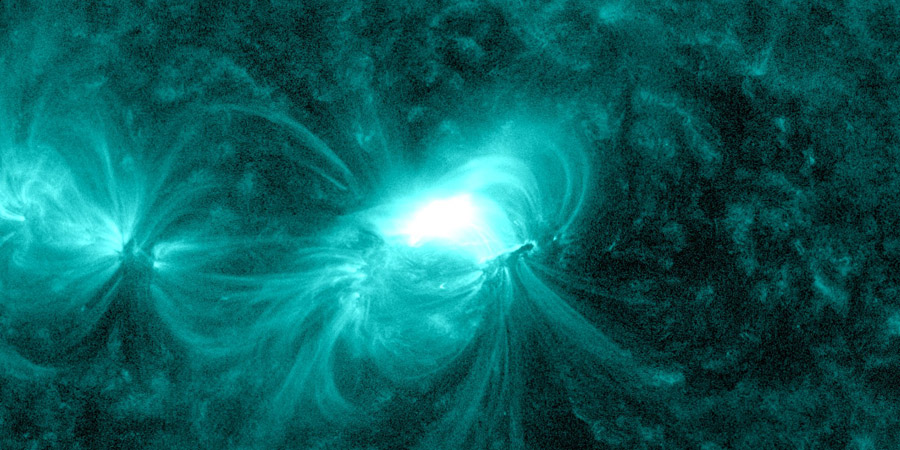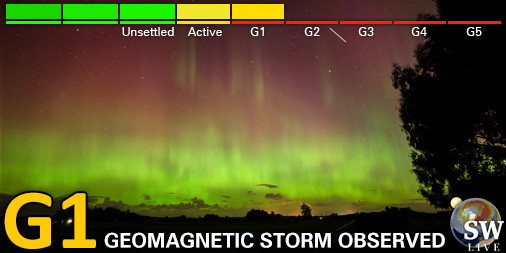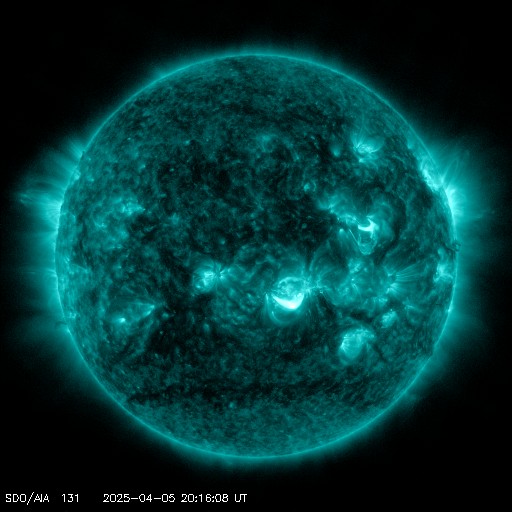M1 solar flare, G2 storm watch
Monday, 31 January 2022 14:24 UTC

Sunspot region 2936 produced an M1.1 solar flare which peaked at 23:32 UTC back on Saturday, 29 January. This large sunspot region was already producing numerous C-class solar flare at the time and developed a Beta-Gamma-Delta magnetic layout. This resulted in a moderate M-class eruption which launched a coronal mass ejection into space. Sunspot region 2936 has quieted down significantly since this eruption and while it remains a large sunspot region, it only has a Beta magnetic layout making more significant flares unlikely.
Coronal mass ejection and G2 storm watch
The M1.1 solar flare did indeed launch a slow asymmetrical full halo coronal mass ejection into space as seen by the SOHO spacecraft watching from Earth's point of view. The bulk of this plasma cloud is heading mostly north-east but we do expect a portion of the cloud to impact our planet.
Looking at the ENLIL solar wind model we see an expected arrival time early on 2 February which is a fair assumption considering the fairly slow speed of this plasma cloud. The NOAA SWPC has issued a moderate G2 (Kp6) geomagnetic storm watch for 2 February. We suspect this might be a tad optimistic due to the coronal mass ejection being fairly slow and not aimed towards Earth head-on but sky watchers should still be on alert in the coming days.
Sunspot region 2936 produced an M1.1 solar flare which peaked at 23:32 UTC. LASCO shows a slow asymmetrical full halo coronal mass ejection leaving the Sun. The bulk is heading north-east but we do expect this cloud to impact Earth in a few days. More info later. pic.twitter.com/WqMIWHNUAY
— SpaceWeatherLive (@_SpaceWeather_) January 30, 2022
The M1 CME from 29 Jan is predicted to arrive at Earth early on 2 Feb according to the ENLIL model.
— SpaceWeatherLive (@_SpaceWeather_) January 31, 2022
Moderate G2 (Kp6) storm conditions are possible according to the NOAA SWPC. We suspect this might be a tad optimistic but sky watchers should be on alert in the coming days. pic.twitter.com/tIUJsK3WYb
Thank you for reading this article! Did you have any trouble with the technical terms used in this article? Our help section is the place to be where you can find in-depth articles, a FAQ and a list with common abbreviations. Still puzzled? Just post on our forum where we will help you the best we can!
Current data suggests there is a slight possibility for aurora to appear at the following high latitude regions in the near future
Fairbanks, AKLatest news
Latest forum messages
Support SpaceWeatherLive.com!
A lot of people come to SpaceWeatherLive to follow the Sun's activity or if there is aurora to be seen, but with more traffic comes higher server costs. Consider a donation if you enjoy SpaceWeatherLive so we can keep the website online!

Latest alerts
02:00 UTC - Geomagnetic activity
Minor G1 geomagnetic storm (Kp5) Threshold Reached: 01:50 UTC
Saturday, 5 April 2025
20:30 UTC - Geomagnetic activity
Minor G1 geomagnetic storm (Kp5) Threshold Reached: 20:20 UTC
20:24 UTC - Solar flare
Moderate M1.05 flare
20:09 UTC - Radio Blackout
Minor R1 radio blackout in progress (≥M1 - current: M1.05)
10:00 UTC - Hemispheric Power Index
The OVATION model predicts the Hemispheric Power Index to reach 78GW at 10:32 UTC
Space weather facts
| Last X-flare | 2025/03/28 | X1.1 |
| Last M-flare | 2025/04/05 | M1.0 |
| Last geomagnetic storm | 2025/04/05 | Kp6- (G2) |
| Spotless days | |
|---|---|
| Last spotless day | 2022/06/08 |
| Monthly mean Sunspot Number | |
|---|---|
| March 2025 | 134.2 -20.4 |
| April 2025 | 150.4 +16.2 |
| Last 30 days | 131.6 -13.4 |





